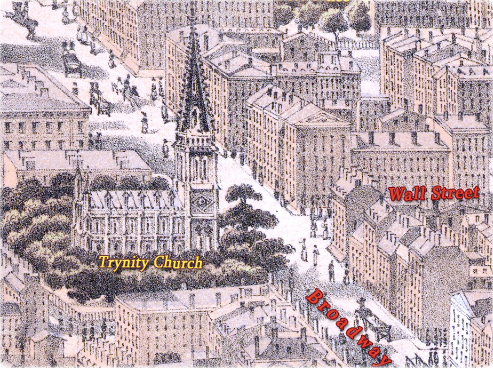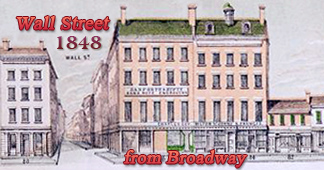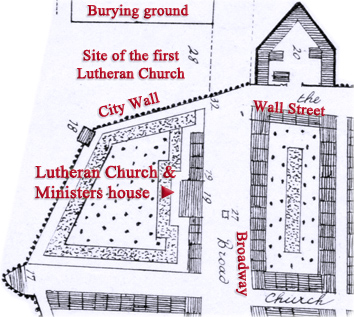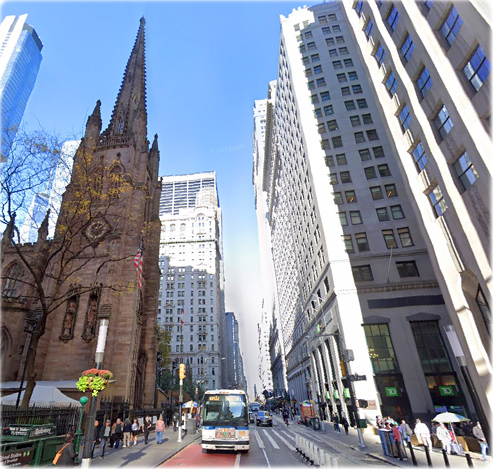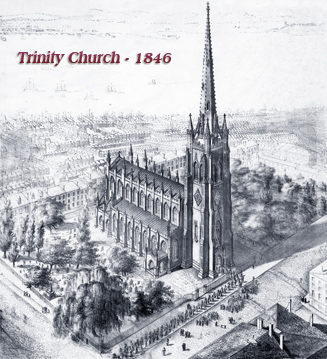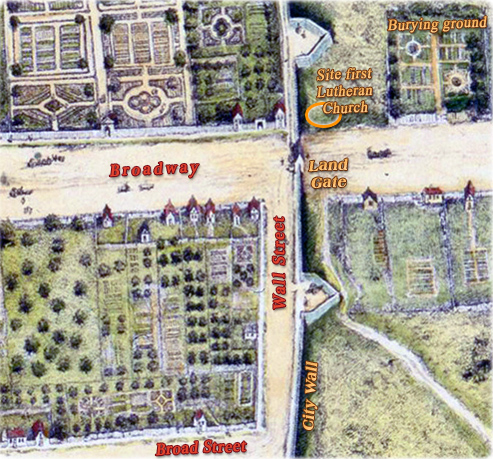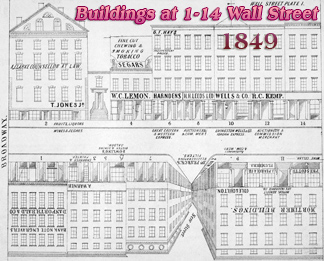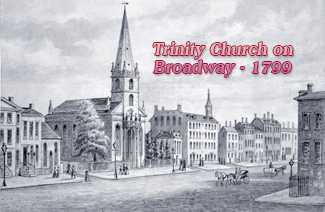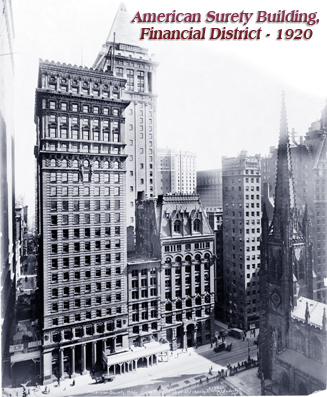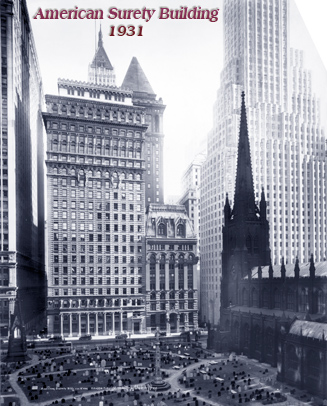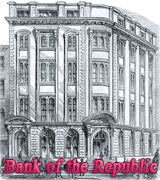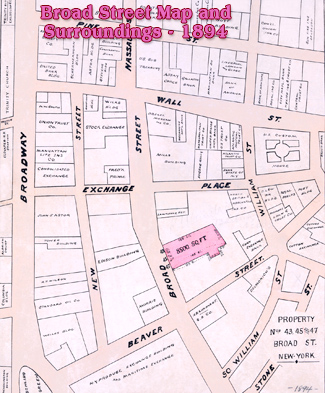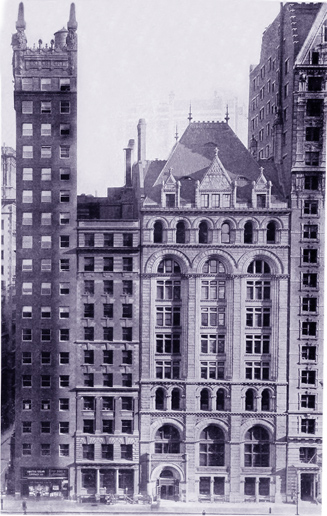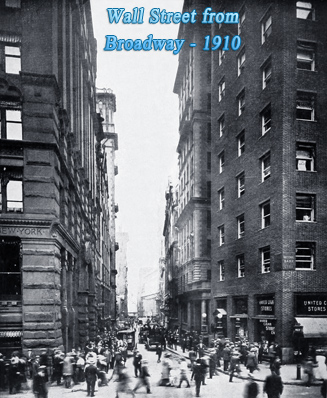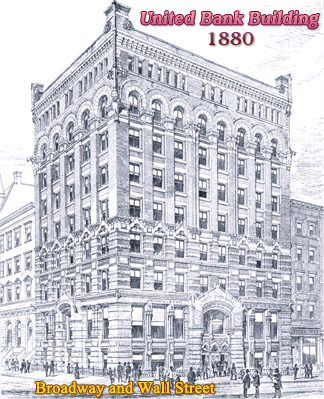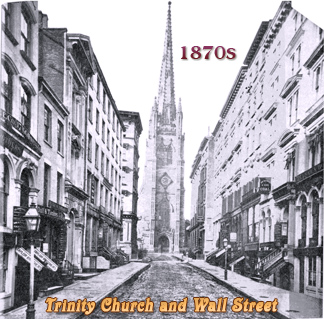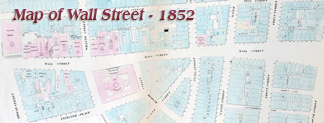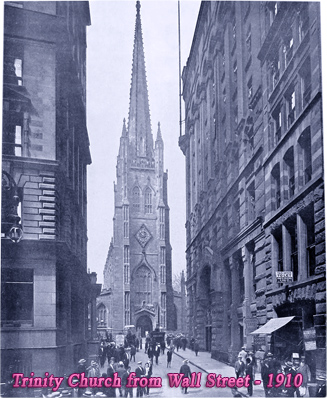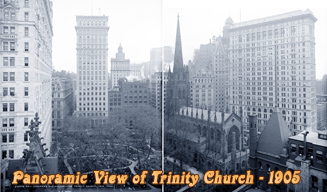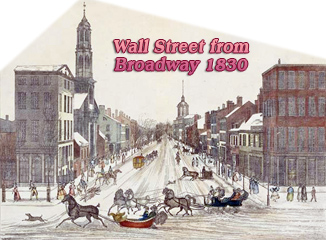 Wall Street runs from Broadway
at Trinity Church to the East River waterfront, at South Street, in the
Financial District, in Lower Manhattan. In the first half of the 17th century
this area was outside the Dutch settlement of New Amsterdam.
Wall Street runs from Broadway
at Trinity Church to the East River waterfront, at South Street, in the
Financial District, in Lower Manhattan. In the first half of the 17th century
this area was outside the Dutch settlement of New Amsterdam.
 In 1653, during the first Anglo-Dutch War, the
City Wall was erected, from
river to river, on the northern limit of the city, located about the present
north side of Wall Street. The wall had two gates:
the Land Gate, on Broadway, and the Water Gate at the foot of Wall Street. Its
structure was changed and renovated several times until the early 1690s, when
the wall began to fall apart. In 1688, the Land Gate on Broadway was said
to be "ready to fall down".
By 1699, the remaining part of the wall had been
demolished or was in ruins.
In 1653, during the first Anglo-Dutch War, the
City Wall was erected, from
river to river, on the northern limit of the city, located about the present
north side of Wall Street. The wall had two gates:
the Land Gate, on Broadway, and the Water Gate at the foot of Wall Street. Its
structure was changed and renovated several times until the early 1690s, when
the wall began to fall apart. In 1688, the Land Gate on Broadway was said
to be "ready to fall down".
By 1699, the remaining part of the wall had been
demolished or was in ruins.
The first Lutheran Church was built on land now a part of the Trinity Churchyard, outside the City gates (map on the right). The Lutheran congregation built its first temple on this original site in 1671. In August 1673, began a brief Dutch reoccupation, which lasted until October 1674. In October 1673 the Dutch Governor ordered to demolish the church for "lying right under the fortifications [the wall]" and build another temple inside the City gates. It was completed about 1676.
In August, 1694, Mayor De Peyster proposed "the Selling of the Vacant Lotts beginning att the West Side of the Wall Street, and running to the Extent of Castor Luersons Ground" for the payment of the city debt. The Common Council approved. A map of 1718 shows that many properties on the north side of Wall Street (where the City Wall stood) belonged to De Peyster family.
On January 27, 1696, took place the first known meeting of what later became the Trinity vestry. They chose to build its temple for the Protestants of the Church of England on the site of the first Lutheran Church and they reached an agreement with the Lutherans to buy the site. By that time the original bastion of the wall, near the site, had been removed. Ground was broken in March, the same year, to build the first Trinity Church and its first formal opening for service was on March 13, 1698. This temple was built facing the Hudson River, it was enlarged in 1735-1737 and destroyed by fire in 1776, during the Independence War.
 The
City Hall on Wall Street was
built in 1699 with stones from the bastions of the wall. The First Presbyterian
Church was originally built in 1719 (as a Presbyterian meeting) on the north side of Wall Street, east of
Broadway. The temple was enlarged in 1748, rebuilt in
1811 and destroyed by fire in 1834.
The
City Hall on Wall Street was
built in 1699 with stones from the bastions of the wall. The First Presbyterian
Church was originally built in 1719 (as a Presbyterian meeting) on the north side of Wall Street, east of
Broadway. The temple was enlarged in 1748, rebuilt in
1811 and destroyed by fire in 1834.
 The
lot on the northeast corner of Broadway and Wall Street was partly occupied by
the City Wall until the late 17th century and it was vacant until the 1730s.
David Grim represented a small structure on the site on his
map of 1742-1744. Before 1775, this
lot was owned by Collin van Gelder. One of his children, the wife of William G.
Forbes, inherited the property, which was sold in 1809 to Najah Taylor and
others as No. 88 Broadway (2 Wall Street). Three small houses were represented
in the 1789 engraving based on a drawing by
Cornelius Tiebout, located to the west of the Federal Hall. A drawing dated
1799 by John Joseph Holland
shows a three-story house on the site. By 1816, the property was owned and
occupied as a store by Najah Taylor and others, with additional floors and gable. It was one of the tallest
commercial buildings in
NYC at the time. By 1848/1849, the building housed offices of Henry Howard
tailor, A. Clarke Counsellor at Law and T. Jones Jr. fruits, liquors, wines and
segars.
The
lot on the northeast corner of Broadway and Wall Street was partly occupied by
the City Wall until the late 17th century and it was vacant until the 1730s.
David Grim represented a small structure on the site on his
map of 1742-1744. Before 1775, this
lot was owned by Collin van Gelder. One of his children, the wife of William G.
Forbes, inherited the property, which was sold in 1809 to Najah Taylor and
others as No. 88 Broadway (2 Wall Street). Three small houses were represented
in the 1789 engraving based on a drawing by
Cornelius Tiebout, located to the west of the Federal Hall. A drawing dated
1799 by John Joseph Holland
shows a three-story house on the site. By 1816, the property was owned and
occupied as a store by Najah Taylor and others, with additional floors and gable. It was one of the tallest
commercial buildings in
NYC at the time. By 1848/1849, the building housed offices of Henry Howard
tailor, A. Clarke Counsellor at Law and T. Jones Jr. fruits, liquors, wines and
segars.
The second temple of Trinity Church was built from 1788 to 1790, facing Wall Street, and demolished in 1839 due to structural problems. The present Gothic temple was consecrated on May 21, 1846, and became the tallest structure in New York City.
The lots on both corners of Broadway and Wall Street are among the most expensive real estate in New York, since 19th century.
Number 1 Wall Street, 86 Broadway, is on the southeast corner. The lot was originally granted to Sybout Claessen, a carpenter, on June 5, 1646, for a house and garden, covering about the present numbers 84 and 86 Broadway. Claessen also received other lots in the same year. The Castello Plan of 1660 (see above right) shows a house on the site. In 1834, the site was occupied by a four-story commercial building, which gained a mansard roof before 1848. That year, the building housed office of Charles Cox tailor and in 1849, offices of Danforth, Bald & Co. and the Bank Note Engravers. The National Bank Note Company, organized in 1859, occupied the building by 1865. This bank printed all U.S. postage stamps from 1861 to 1872. In the 1880s, an agency of the Connecticut Mutual Life Insurance Company occupied the building. This 4-story building was demolished about 1906 and the site was occupied during some month for a one-story cigar store with billboards on top. It was replaced in 1907 by the 18-story office building, known as the "Chimney Building", which was demolished by 1929 to make way for the 50-story Irving Trust Company Building, the present building on the site.
Number 2 Wall Street, 88 Broadway, is on the northeast corner. In 1851, the Bank of the Republic, founded the same year, purchased the lot at the northeast corner of Wall Street and Broadway and built a five-story office building to house its headquarters. It became the National Bank of the Republic in New York in 1865. This building was replaced by the United Bank Building in 1880, demolished in 1931. The present 21-story Two Wall Street was completed on the site in 1933.
Wall Street and Lower Broadway received asphalt pavement in 1890.
